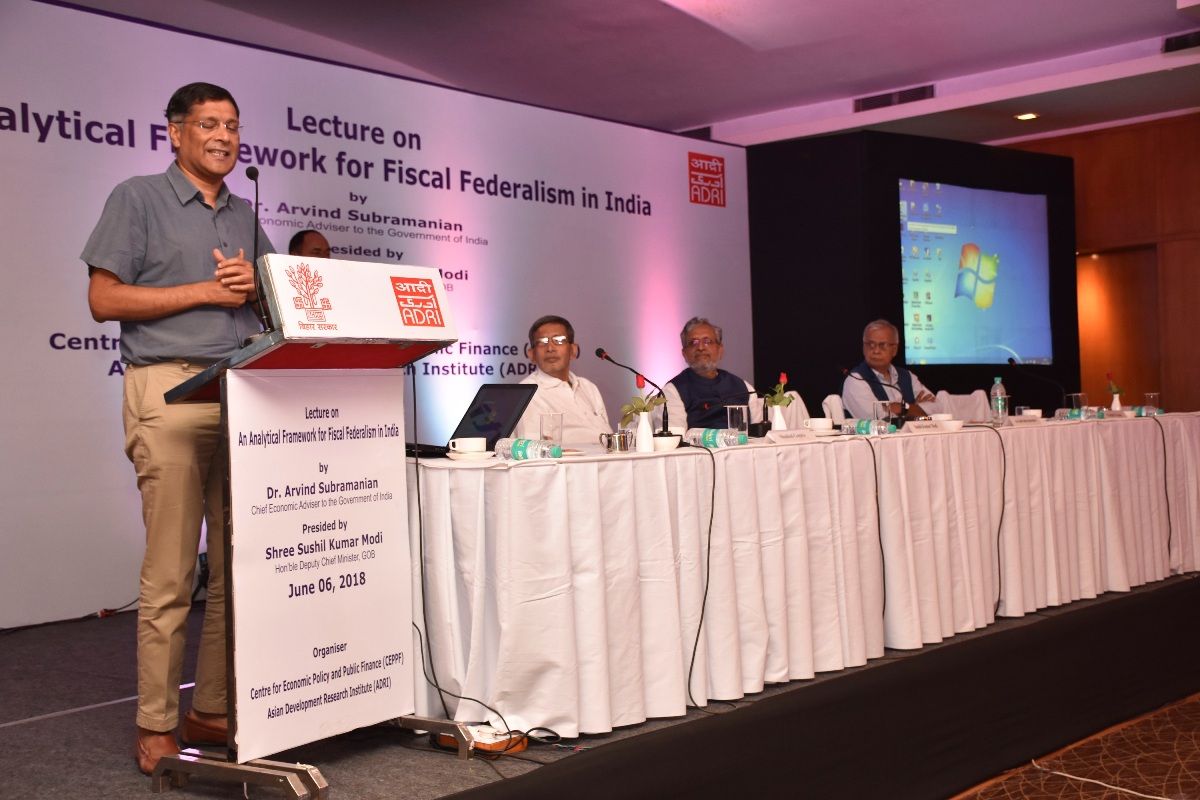Events of CEPPF Patna

Patna, June 6. “Bihar should continue with 10 percent growth in the next 25 years for maintaining its development agenda.” These were the words of Dr Arvind Subramanian, Chief Economic Advisor, Government of India while addressing a lecture on An Analytical Framework for Fiscal Federalism in India. The lecture was organised by Centre for Economic Policy and Public Finance (CEPPF), ADRI.
Dr Subramanian said that Goods and Sales Tax (GST) is an important and revolutionary model of politics, administration and technology. Praising the GST model, he added that this will benefit the consuming states like Bihar. According to him, the state level performance in India can be divided into low level and high level equilibrium and generally third tier government shows low performance. The main reason behind this is the closer the government is to the people, it is more unwilling to raise taxes. He suggested that the second and third tier government should raise own tax revenue by delivering better public services to come out from the trap of low equilibrium.
While discussing about fiscal federalism, he highlighted that there are three R’s which determine the functioning of fiscal federalism. These are: Redistribution, Risk Sharing & Reward. Reacting on central transfers, he said that along with general transfers, there should be special transfers for shock like flood or draught. He stressed upon the fact the transfers should be shock absorbers and Finance Commission should set aside some money for shocks. He also suggested that incentives should be given to 2nd and 3rd tier government for better performance and this could be given as matching grant from the centre.
Shree Sushil Kumar Modi, Hon’ble Deputy Chief Minister, Bihar, in his introductory remarks said that the regional disparity in the states is gradually increasing. While discussing about vertical devolution he cited that there has been increase in states’ share from 28.5% in FC 11 to 42% in FC14 but the share of Bihar in divisible pool is gradually decreasing from 14.6% in FC 11 to 9.66 % in FC14. He said that since past Bihar has been dealing with issues of Permanent Settlement, Freight Equalization etc. Along with this it is overburdened with the pressure of population but even then it has performed well. Reacting upon the concern of the Southern States about 2011 population, Honourable Deputy Chief Minister said that population 2011 has already been introduced as demographic change with 10% weight in FC 14. So this is not new concept for Finance Commission. He also added that Bihar suffers the vagaries of flood every two years but got only Rs. 2591 crore compared to Maharashtra (Rs. 8095 crore), MP (Rs. 4848 crore). Finally he suggested that GST model where state and Centre surrenders its sovereignty is the ideal model of co-operative federalism and should be followed by FC.
Opening the session, Dr. Shaibal Gupta, Director, CEPPF, in his welcome remarks said that the Indian Constitution does provide a mechanism to address the issue of fiscal federalism, but the constitution does not provide a theoretical framework for that challenging exercise. Appreciating the academic contributions of Dr. Subramanian, Dr. Gupta said that it is the unwritten responsibility of the scholars like Dr. Subramanian to suggest such a framework.
Professor Prabhat P Ghosh, Director, ADRI, read the vote of thanks on the occasion. Shree Arun Kumar Mishra, Additional Secretary, Commercial Tax Department, Shree Tripurari Sharan, Principal Secretary, Department of Forest and Environment, Shree A.K. Verma, Additional Secretary, Commercial Tax Department, Shree Dilip Sinha, IFS (Rtd.), Shree Rameshwar Singh, Professor Dolly Sinha, Professor Daizy Banerjee, Professor Kumadani Sinha, Dr. Sunita Lall, Dr. Ashmita Gupta, etc. were present on the occasion. Economists, intellectuals, and faculty members and students from prominent academic institutions had their queries answered during the Q&A session that followed the lecture by the Chief Economic Advisor.